It was the 1960's. Every amusement park in the country was feeling the effects of the Disneyland concept. Themed lands. Rides, restaurants and shops all designed around a central concept, an idea, a "theme." Cedar Point in Sandusky, Ohio was no exception to this — the phrase "The Disneyland of the Midwest" was bandied about often when describing Cedar Point, and unless it took up that challenge it risked being left in the dust of more aggressive parks. Thus in 1967 was born the first truly themed area at Cedar Point — Frontier Town.
Frontier Town started off much smaller than its present size. It contained just a few structures — a saloon/theatre, some shops and games, one major ride (the original Shoot-The-Rapids water ride, located where Maverick is today), and that was about it. What made Frontier Town unlike any other themed land in any park was its location. The site of Frontier Town was carved out of a heavily-forested area on the western tip of the Cedar Point peninsula, far away from the main Midway. Visitors to Cedar Point had only one way to get there — the Cedar Point and Lake Erie Railroad, which up to this point had only been used as an attraction that took guests past created scenes of early pioneer America. There was no walking path to Frontier Town, no public road to drive there. You had to take the train to the Frontier Town Station. This was a unique feature, unlike any other themed land anywhere, and I remember as a child how much fun it was to board the train at the colorful excitement of the Midway Station, ride through the forest and along the coast of Lake Erie and the Sandusky Bay and soon arrive at a pioneer town carved out of the wilderness, a town with wooden sidewalks, a wild west saloon and — to a ten-year-old boy in 1967 — the biggest water ride I had ever seen.
The popularity of Frontier Town with Cedar Point guests made it obvious that it would need to be developed further, and in 1968 the Frontier Lift, a skyride connecting the Midway with Frontier Town, was installed. This relaxing ride carried guests through the forest at tree-top level, and was a wonderful way to transition from the excitement of the Midway to the slower pace of Frontier Town. The Midway station was located where the Iron Dragon loading station now stands, but the Frontier Town station still stands next to the Town Square, where it provides restroom and changing facilities for guests getting drenched on the nearby Thunder Falls and White Water Landing rides. Several major additions to Frontier Town followed in 1969: the Antique Cars, a duplicate of the popular guest-driven Cadillac Cars on the Midway; the Town Hall Museum, which showcased the rich history of Cedar Point (and was air-conditioned!); and the newest roller coaster at Cedar Point, the Cedar Creek Mine Ride, one of the first steel tubular coasters in the country.
Frontier Town has continued to evolve over the years, with the addition of new attractions and the removal of others, but that is material for a future article. This article covers the creation of one of the most unusual themed areas in any park in the world, an area of American culture, crafts and traditions that perhaps could only work in America's second oldest amusement park, Cedar Point.
This is the Frontier Trail.
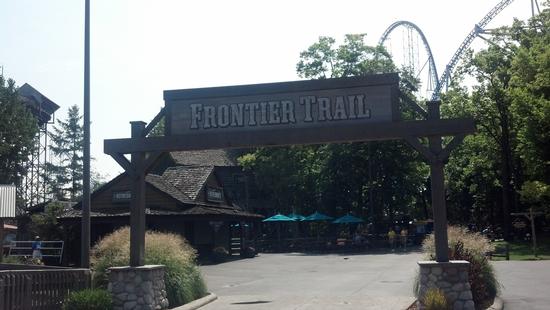
In 1971, Cedar Point opened a walking trail connecting the new "Million Dollar Midway", (actually just an extension of the original Midway) with Frontier Town. Guests could finally walk to Frontier Town and not have to rely on the C.E. & L.E. Railroad or Frontier Lift to visit this increasingly-popular area of the park. Cedar Point could have just provided a nice-surfaced walking path wandering through the forest, but decided to make this area an attraction itself. Original log cabins from all over northwest Ohio were dismantled and reconstructed along the Trail, new structures were constructed to augment these historic cabins, and an important tribute to the early pioneers that settled the wilderness that became Ohio was created.
For the purpose of this article, I will refer to structure as "historic" and "non-historic." A "historic" structure is one that was built sometime in the past elsewhere and moved to Cedar Point, where it was reconstructed on Frontier Trail. "Non-historic" is one built on site by Cedar Point to provide additional merchant or craft space for the Frontier Trail. All structures on Frontier Trail are built in a period-appropriate style, to fit into the historic pioneer "feel" of this part of the park.
The Frontier Trail can be entered from either end. I will describe the trail starting at the Midway entrance, where guests are funneled into the Trail from the large plaza in front of the Millennium Force entrance. The first structures guests will see are the Panda Express restaurant on the left and the Red Garter Saloon on the right. Panda Express is in a non-historic one-story structure that first housed Aunt Em's, which sometimes was called the Pie Shop. It has changed names several times over the years. "Chicken BBQ" was added for several years when a large outdoor chicken BBQ grill was set up next door, and in 2000 it became "Coyote Cody's and Dastardly Dan's" until 2007, when it became an outlet for Panda Express.
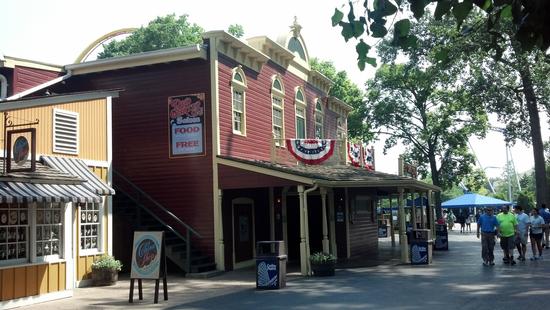
Across the Trail from Panda Express are three connected non-historic structures, the two-story Red Garter Saloon flanked by an "old time photography studio" on the right, which on early maps of the Trail is listed as an apothecary shop, and the China Shop, which originally was a print shop. The Red Garter Saloon anchors this end of Frontier Trail, and is one of the most popular entertainment facilities at Cedar Point. This recreation of a higher-class Wild West saloon, decorated in Steamboat Baroque style, has offered food, drinks and live entertainment to Cedar Point guests since it opened in 1971. Small tables and chairs fill the ground floor and spacious balcony, and a beautiful bar occupies one entire wall. The entertainment here has changed many times over the years, but has always featured talented entertainers performing music from country to pop (with an occasional karaoke night on the performers' night off). The food (sandwiches, nachos, beer and soft drinks, etc.) always has been adequate; the entertainment always has been of good enough quality to usually pack the place for each performance, and the atmosphere of a wild west saloon always has made the Red Garter Saloon a place we almost always visit at Cedar Point.
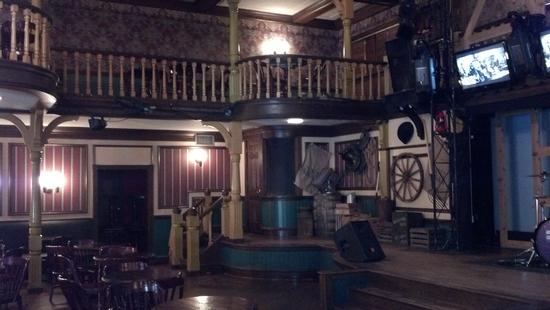
Proceeding down the Trail the next structures you pass are (on the left) non-historic C.J.'s Provisions and Toot Sweets (candy and snacks) and (on the right) the Coca Cola Marketplace, formerly the Cedar Junction Train Station until this year. This station was not a working station for the Cedar Point and Lake Erie Railroad (although it is connected by a rail spur) but was an open-air platform which over the years housed a old caboose and now displays one of Cedar Point's historic steam engines, the 1910 "Albert." Photos of the other C.P & L.E. steam engines and their history were once mounted on the station railings, but these have been replaced this year with cases of Coca Cola products, along with fresh fruit and fruit drinks for purchase. Personally, I find it an eyesore, a commercial intrusion into the atmosphere of Frontier Trail.
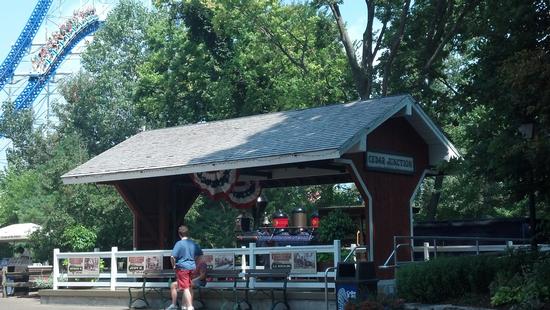
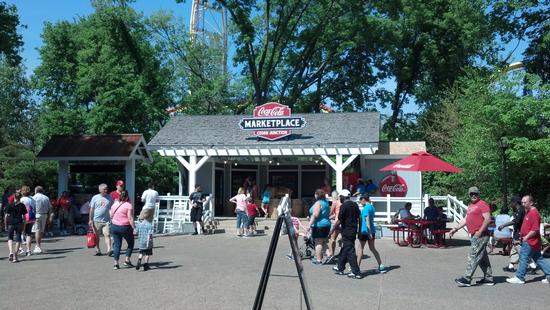
Here is the next major intrusion to the original Frontier Trail. The tracks for Millennium Force cross the trail, but Cedar Point designed a creative way to mask the tracks and lessen the noise of the speeding coaster trains and screaming riders. A gray stone cliff beautifully landscaped with trees, bushes and flowers crosses the trail, hiding most of the blue coaster track and muffling (slightly) the roar of the coaster. Guests strolling down the Trail find a tunnel through the cliff designed to resemble one of the many wooden covered bridges still found throughout northern Ohio.
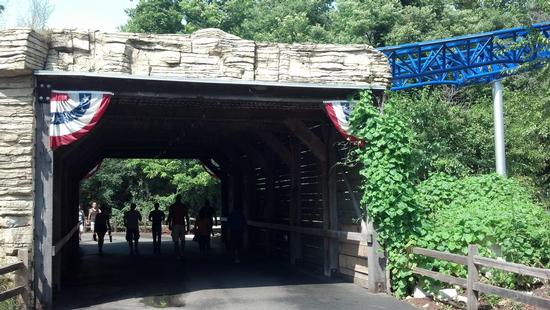
After passing through the tunnel guests find on their right a path leading to the E.J. Hammer Blacksmith Shop, where a working blacksmith can often be found pumping the bellows, hammering red-hot iron and creating a wide variety of metal items available for purchase in the connected shop.
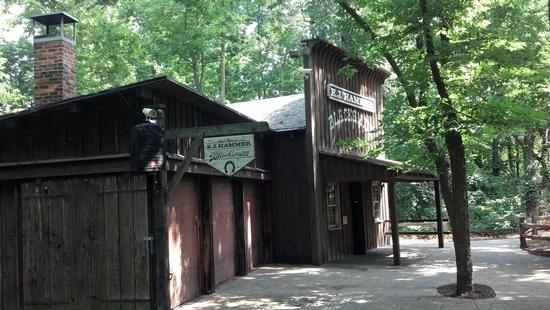
Across the Trail from the blacksmith is a historic building that was once called the Woodworking Shop, then the Toy Barn, where a variety of wooden (and other) toys were available. This historic log barn has been completely refurbished this year and now is the Trail Tavern, and serves local wines (few people realize that northern Ohio is one of the nation's largest producers of wine), beers, fruit, cheese and crackers. The Trail Tavern is beautifully designed and decorated and a welcome addition to Frontier Trail.
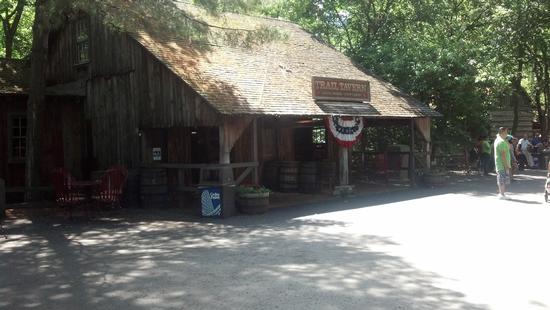
Passing Dr. Phil McCoffer's Medicine Wagon, headquarters of the Frontier Folks and Bluegrass Jamboree (a roving troupe of musicians and entertainers that perform throughout the Trail) guests approach the heart of Frontier Trail, Fort Sandusky and the Log Cabin Settlement. Fort Sandusky is a recreation of a British fort built in 1761. It consists of a stone blockhouse and log stockade, and while it is not an exact reconstruction of the original fort, which was burned in 1763 during the Native American uprising called the Pontiac Conspiracy, it gives a good impression of the frontier forts that provided protection for early settlers and traders in what was then the densely forested wilderness along the Lake Erie coast. Several souvenir shops are inside the small fort.
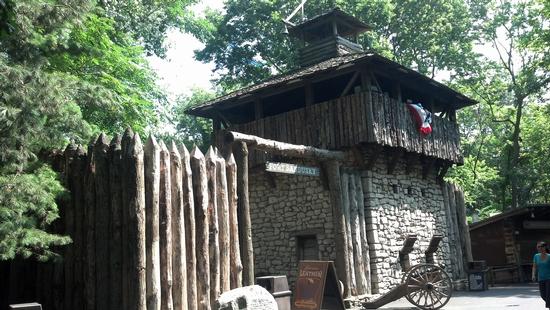
Across the Trail from Fort Sandusky is the Log Cabin Settlement, a collection of four log cabins containing craft and merchandise for purchase.
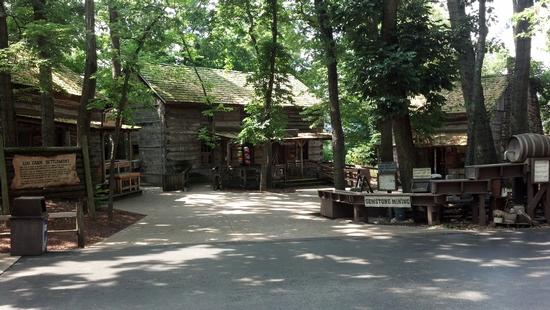
They are, from left to right: Paul's Woodcarver Shop, where a skilled wood carver is often seen working on a hand-carved wooden sculpture or constructing wooden toys, the Fort Sandusky Mining Company, the Frontier Merchant, and the Erie County Custom Jewelry shop. These cabins are each unique in structure and size, some being two stories high, but unfortunately finding out the history of them has been difficult. There are no historic markers on them detailing the background of the cabins, where they came from or when built. One newspaper article I found stated that one of the cabins was built in 1828 near Wauseon, Ohio, and that another was over 100 years old and was from near Tiffin, Ohio (my home town!) That was frustrating, and a missed opportunity for Cedar Point to expand the educational opportunities here. Also, except for the Wood Shop, the merchandise available was fairly run-of-the-mill souvenirs neither period appropriate or especially memorable. Another missed opportunity.
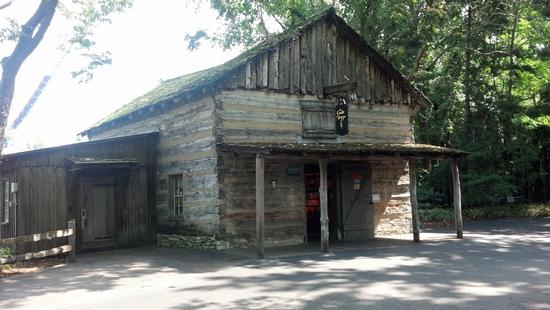
Returning to the Frontier Trail, on the right side is the Candle Shop, the only cabin with a historic marker on it detailing its history:
The Hessenauer Cabin
originally near Galion, Ohio
Built about 1835
by Early Settler Adam Remsch
Inside is a large collection of candles for purchase, and guests can hand-dip their own candles.
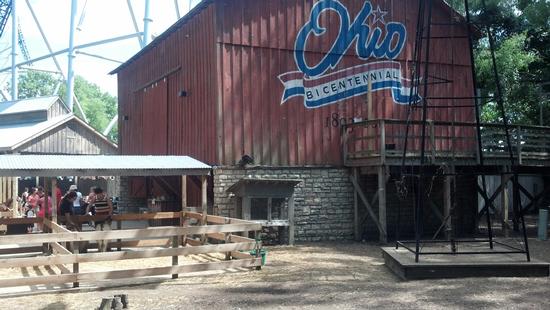
Across the Trail is the Barnyard, once one of the quietest parts of Frontier Trail, but this year one of the most exciting. A large, traditional barn and open-air shed once housed old steam tractors and a few animals to pet. This year it has been completely refurbished into a bustling barnyard with pens of goats, sheep, miniature cows, rabbits, and even llamas (or alpacas — I can never tell them apart). Ponds have been repaired and ducks and geese swim past turkeys, chickens and other barnyard animals. Once largely ignored, the Barnyard was filled with families happily petting the animals, feeding them (with food provided by the Barnyard for a small fee), and not realizing that they were rediscovering our agricultural history. Somehow the presence of Millennium Force towering overhead and the screams from its riders is ignored or forgotten.
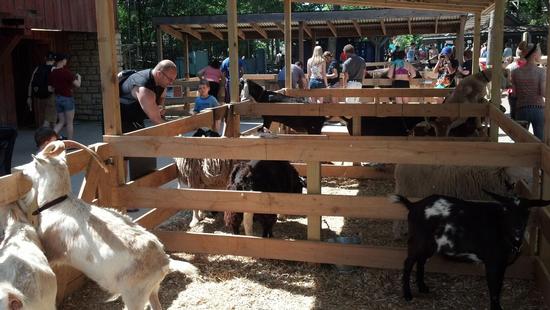
The Addington Mill is a complete water-powered grist mill, brought to Cedar Point in 1971 from Macon County, North Carolina. This two-story wooden structure, complete with water flume and massive grist stones, was built in 1861 (although for some reason the sign on the front of the building states that it was "Established 1835") and is unique in that nearly all of its original machinery is constructed of wood and was never "modernized" with metal equipment. The only change from its original equipment was the replacement of its wooden water wheel with a metal one in 1927. The interior is a maze of wooden wheels, cogs and axels, and while it no longer is operational, its preservation by Cedar Point is a valuable addition to Frontier Trail.
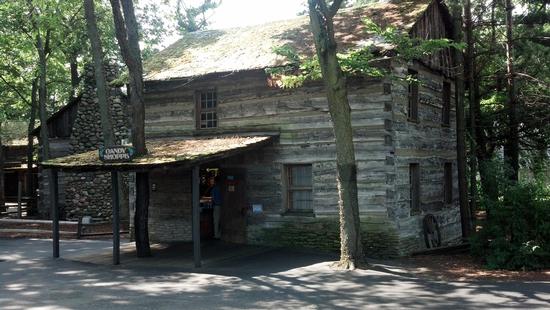
One last historic structure, originally called the "Trading Post" but now signed as the "Candy Shoppe," stands across from the Addington Mill. It is an attractive log cabin, two stories in height, with a front porch whose roof was built around a large tree in front of the cabin.
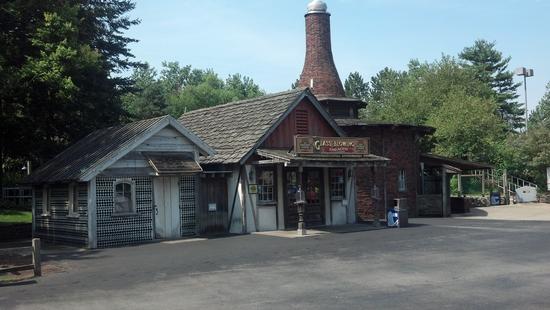
The last structure on Frontier Trail (or the first one if you enter it from Frontier Town) is the Glass Blowing Theater and Shop. This non-historic building is also one of the most unique at Cedar Point, and is actually a series of connected structures: from right to left is the open-air glass blowing amphitheater with its massive brick furnace and towering smokestack, a wooden shop where many of the glass pieces created by the talented glass-blowers next door can be purchased, and a small structure whose walls are composed almost exclusively from multi-colored glass bottles laid on their sides and held together by mortar. Skilled craftspeople hand-blow molten globs of glass into beautiful vases, goblets and objects des art in front of dozens of guests sitting in a covered, curved theater, recreating an era when northern Ohio was one of the nation's centers of glass production.
There are other structures found along Frontier Trail that I haven't mentioned, mostly because they are not significant and partly because, personally, I find them intrusive in this area. Henna tattoos, the Panda Express restaurant, caricature artists, and the Coca Cola Marketplace replacing the original Cedar Junction Train Station intrude on the atmosphere that originally made this part of Cedar Point both special and unique. A major ride attraction, Shoot the Rapids, is also located on the Trail, but at least it has been well themed to fit into the area, and it does pay tribute to Crystal Rock Beer, a now-gone local brew that has a prominent place in early Cedar Point history.
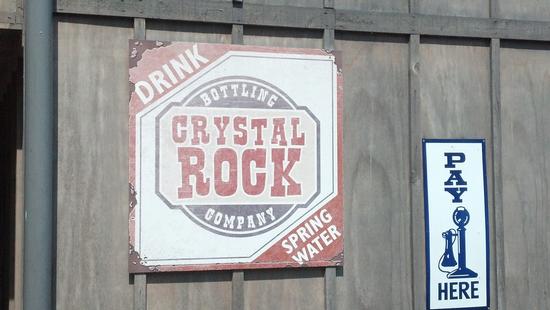
For over 40 years the Frontier Trail at Cedar Point has provided guests a place to relax a bit, slow down, rediscover the history of the pioneers who settled northern Ohio and still have fun. The "purity" of this experience has been intruded on from time-to-time with out-of-place attractions, but for the most part it remains today what it was in 1971 — a relaxing tree-shaded path lined with historic structures where guests can watch blacksmithing, glass blowing, candle making, woodcarving, drink a beer in a frontier saloon, get "locked" in the stocks, and generally have a nice, quiet, fun experience away from the excitement of the rest of Cedar Point (mostly).

Yes, if you listen for it, you can hear the roar of Millennium Force and the screams of its riders as it cuts across the Trail. Yes, if you look for it, you can see soaking-wet guests wringing out their clothes after riding Shoot the Rapids or the nearby Thunder Canyon. If you want to, you can notice the caricature artist stand or the garish Coca Cola Marketplace where the train station should be...but when most people think of Frontier Trail they think of Fort Sandusky, of the log cabin settlement, of the heat from the glass blowing furnace and the smell of the coal at the blacksmith shop, of the smell of kettle corn being cooked.
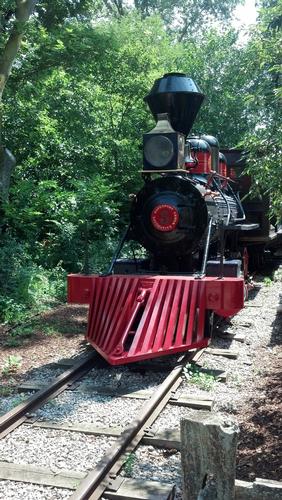
Frontier Trail at Cedar Point — a historic path through early America's frontier life.
TweetFantastic article. In the mid 70's my company transferred me to Toledo. We were just 30 to 40 minutes from Cedar Point, so we went there often. The Western area and the Frontier Trail were my first experiences with themed areas of amusement parks and I thoroughly enjoyed them.They were by far my favorite areas of the park. I always wished Cedar Point would have continued with developing themed areas but I guess the economics of the situation caused them to go in a different direction with converting from a couple of mild coasters into arguably the premier coaster amusement park. It's good, though, to see that they have stayed the course with these themed areas. Perhaps, it's influence generated from Matt Oumitt similar to what he's doing at Knott's.
Just to add a bit. During those times they also had the themed Riverboat area through the swamp/waterway in the middle of Cedar Point and the themed island where they had an excellent Jungle animals/show attraction. Cedar Point sure looked a lot different in the 70's. Barely recognizable to what is there now, since so much of the island/peninsula that Cedar Point is on was then woodland and water passages/swamps.
Rob, those waterways were dug in the late 1800's/early 1900's to allow coal barges to bring fuel directly to the Cedar Point power generating plant without having to unload and haul it overland. Before Cedar Point became such a high-energy resort, these waterways also provided a relaxing location for courting couples to rent rowboats and canoes and explore some of the more "private" locations on the densely-forested Cedar Point peninsula.
The jungle island you mentioned was Jungle Larry's Safari Island, and was an island in these waterways accessible to visitors via a floating bridge. It was located roughly where Power Tower is now. It had a wide variety of animals that performed shows throughout the day. These animals spent the summer at Cedar Point and the winter season in Florida.
Jungle Larry, that's the name I was trying to remember but couldn't. Thanks for the reminder & that's a very interesting story about the canals. Yes, the park was especially beautiful then. Not that's it's still very scenic, but perhaps a bit more pristine then. But there are very more attractions now.
A fantastic article! I can remember going to the top of Fort Sandusky when I was a wee tot. The first steps have been removed and the top floor is now occupied with equipment for the former Starlight Experience and is not open to the public. The only correction I have for you is that the old midway-side for the Frontier lift was where Coasters restaurant is now, not the Iron Dragon station. (I checked some old aerial photographs to verify). Great article!
Great article, thanks. I grew up in Texas and Six Flags was my home park, so I never got to see Cedar Point in the 70's, but your descriptions make me wish I had. I started visiting CP in 2003 and have not missed a year since. Thanks again.
Great article, James. You really painted Cedar Point in a new light, one which I am excited to witness in person come August.
Based on your descriptions (and pictures) Frontier Trail seems to have a lot in common with Silver Dollar City down in Branson, MO (my favorite park outside of Orlando and SoCal). I think you would get a real kick out of SDC especially since they do not have a Panda Express ruining the theme.
Great article, James! I had no idea that Cedar Point had themed areas like this since most of what you hear about CP is about the coasters, but your article is making me reconsider the ranking I've given a trip to Cedar Point on my bucket list.
Great article!! Now retired, I remember Frontier Town and the Frontier Trail being added as an attraction to Cedar Point. Our kids at that time are now grown up and have families(our grandkids)of their own. We still try to make going to Cedar Point an annual affair but now with all the older "kids" and the Grandkids and always take the walk down Frontier Trail, a real memory Lane. Thank you so much for giving us this memory.
Gene Ellerbrock
Kalida, Ohio
This article has been archived and is no longer accepting comments.
This season the park really seems to have focused on making Frontier Trail a "place" again with improvements like the Barnyard and the Trail Tavern. The addition of the Frontier Folks last year and the Bluegrass Jamboree this year have brought new life to the entire Trail. One of the more pleasant and subtle changes has been the switch in the area music to instrumental bluegrass instead of contemporary country. It might be the same loop (bluegrass "covers" of rock and pop songs) that now plays at Knott's Ghost Town. Area music may seem like a small thing but it goes a long way toward establishing a mood/vibe for a themed section of a park.